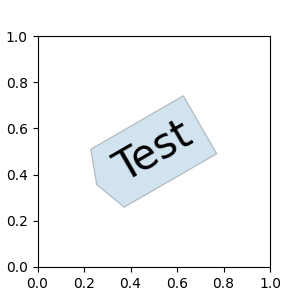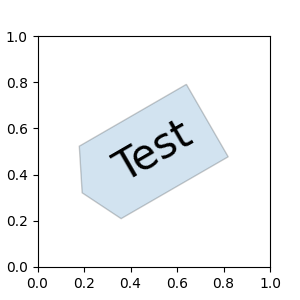注解
Click here 下载完整的示例代码
自定义方框样式¶
此示例演示了自定义 BoxStyle . 自定义 ConnectionStyle S和 ArrowStyle s可以类似地定义。
from matplotlib.patches import BoxStyle
from matplotlib.path import Path
import matplotlib.pyplot as plt
自定义框样式可以实现为一个函数,该函数接受指定矩形框和“变异”量的参数,并返回“变异”路径。具体签名是 custom_box_style 下面。
在这里,我们返回一个新路径,在框的左侧添加一个“箭头”形状。
然后可以通过传递 bbox=dict(boxstyle=custom_box_style, ...) 到 Axes.text .
def custom_box_style(x0, y0, width, height, mutation_size, mutation_aspect=1):
"""
Given the location and size of the box, return the path of the box around
it.
Rotation is automatically taken care of.
Parameters
----------
x0, y0, width, height : float
Box location and size.
mutation_size : float
Mutation reference scale, typically the text font size.
mutation_aspect
Mutation aspect ratio.
"""
# We ignore mutation_aspect. This is okay in general.
# padding
mypad = 0.3
pad = mutation_size * mypad
# width and height with padding added.
width = width + 2 * pad
height = height + 2 * pad
# boundary of the padded box
x0, y0 = x0 - pad, y0 - pad
x1, y1 = x0 + width, y0 + height
# return the new path
return Path([(x0, y0),
(x1, y0), (x1, y1), (x0, y1),
(x0-pad, (y0+y1)/2), (x0, y0),
(x0, y0)],
closed=True)
fig, ax = plt.subplots(figsize=(3, 3))
ax.text(0.5, 0.5, "Test", size=30, va="center", ha="center", rotation=30,
bbox=dict(boxstyle=custom_box_style, alpha=0.2))

出:
Text(0.5, 0.5, 'Test')
或者,自定义框样式可以实现为 matplotlib.patches.BoxStyle._Base ,通过重写 transmute 方法,如下所示。
然后可以将子类注册到 BoxStyle._style_list dict,它允许将框样式指定为字符串, bbox=dict(boxstyle="registered_name,param=value,...", ...) .
请注意,这种方法依赖于内部api,因此不受官方支持。
class MyStyle(BoxStyle._Base):
"""A simple box."""
def __init__(self, pad=0.3):
"""
The arguments must be floats and have default values.
Parameters
----------
pad : float
amount of padding
"""
self.pad = pad
super().__init__()
def transmute(self, x0, y0, width, height, mutation_size):
"""
Given the location and size of the box, return the path of the box
around it.
Rotation is automatically taken care of.
Parameters
----------
x0, y0, width, height : float
Box location and size.
mutation_size : float
Reference scale for the mutation, typically the text font size.
Notes
-----
Unlike when defining the box style as a function (as in
`custom_box_style`), here there is no *mutation_aspect* parameter.
Matplotlib will first squeeze the box's y-axis by *mutation_aspect*
before calling the `transmute` method, and then later reexpand the
y-axis by the same amount.
"""
# padding
pad = mutation_size * self.pad
# width and height with padding added
width = width + 2.*pad
height = height + 2.*pad
# boundary of the padded box
x0, y0 = x0 - pad, y0 - pad
x1, y1 = x0 + width, y0 + height
# return the new path
return Path([(x0, y0),
(x1, y0), (x1, y1), (x0, y1),
(x0-pad, (y0+y1)/2.), (x0, y0),
(x0, y0)],
closed=True)
BoxStyle._style_list["angled"] = MyStyle # Register the custom style.
fig, ax = plt.subplots(figsize=(3, 3))
ax.text(0.5, 0.5, "Test", size=30, va="center", ha="center", rotation=30,
bbox=dict(boxstyle="angled,pad=0.5", alpha=0.2))
del BoxStyle._style_list["angled"] # Unregister it.
plt.show()

关键词:matplotlib代码示例,codex,python plot,pyplot Gallery generated by Sphinx-Gallery